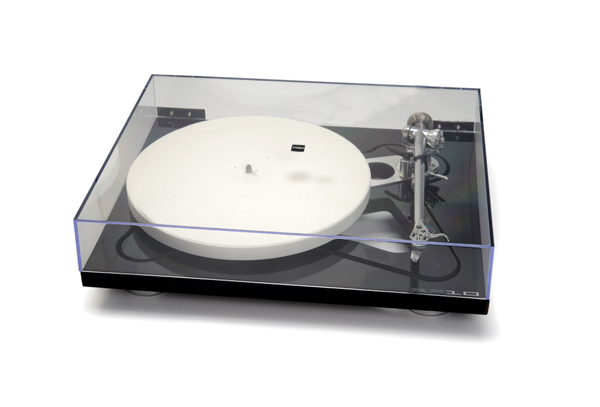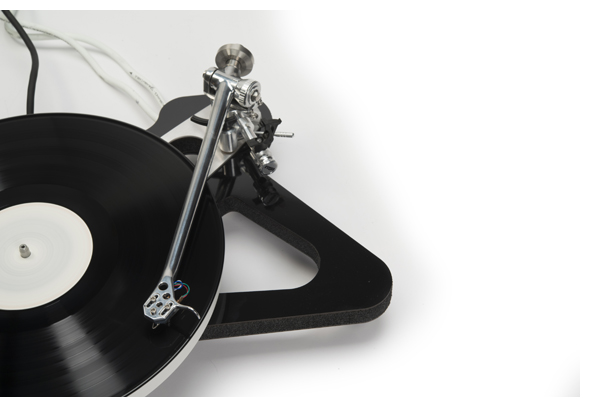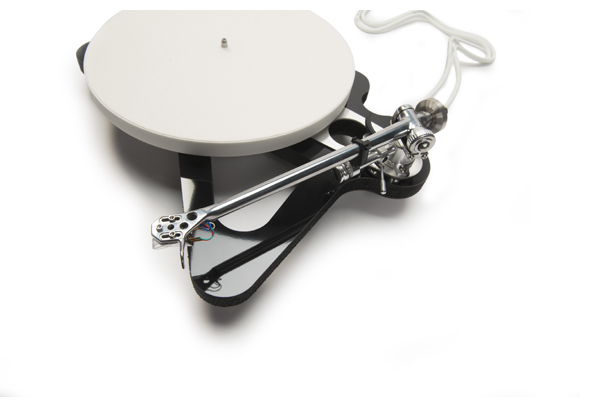Rega RP10 Turntable
 Our publisher has been a Rega fan since the fateful day in the mid-’80s when we happened by our local dealer (Audio Emporium in Milwaukee, Wisconsin) to find them opening a shipment of Planar 3 turntables. As they lifted a bright, fluorescent green table out, the sales guy quipped, “What idiot would buy a turntable in this color?” Little did he know that’s been publisher Dorgay’s favorite color since age 6. He solemnly replied, “I’m that idiot!” and we took that little British table back to his listening room and were subsequently blown away, being Technics SL-1200 guys at that moment in time, thinking there couldn’t possibly be anything better than direct drive.
Our publisher has been a Rega fan since the fateful day in the mid-’80s when we happened by our local dealer (Audio Emporium in Milwaukee, Wisconsin) to find them opening a shipment of Planar 3 turntables. As they lifted a bright, fluorescent green table out, the sales guy quipped, “What idiot would buy a turntable in this color?” Little did he know that’s been publisher Dorgay’s favorite color since age 6. He solemnly replied, “I’m that idiot!” and we took that little British table back to his listening room and were subsequently blown away, being Technics SL-1200 guys at that moment in time, thinking there couldn’t possibly be anything better than direct drive.
Words like pace and timing weren’t even part of our vocabulary back then, but there was a ton of inner detail coming through those Magnepan MGII speakers that wasn’t there the day before, and to this day, both of us have always owned at least one Rega turntable. For the record, my current reference is a P9 with Apheta cartridge, and it has served me well for some time now.
Evolution no. 10
Someone once said that an elephant is only a mouse built to military specifications, and on one level the same could be said for the P9 – you could think of it as a fully geeked-out P3. The platter, drive mechanism, tonearm and power supply are all highly evolved versions of the basic Rega turntable. For those of you that aren’t familiar, the tonearm on the earlier P3 and P9 shared the same basic casting, and now the new RP10 uses a highly refined version of the new casting for the RP3 (and is secured with the same red tape Rega has used for decades), yet the new RB2000 is completely handmade and finished to the highest of tolerances, as was the RB1000.
According to Rega, the RB2000 arm “is designed to have a minimum of mechanical joints while using the stiffest materials possible in all areas.” Like its predecessor, the bearings are hand fitted and of highest quality, all handpicked for tolerance before insertion into the arm.
A new twist on the Rega platform, beginning with the RP3, is the mechanical brace: magnesium in the RP10, going between the tonearm mount and the turntable bearing, assuring maximum rigidity between these critical areas, while taking advantage of the new, skeletal plinth (further refined from the RP8 design) having seven times less mass than the original Planar 3.
An ex-automotive engineer, Rega principal Roy Gandy has always taken the advantage that less mass means more energy transferred from the record groove to the stylus tip, an opposite philosophy of the “more mass is better” approach embraced by some other manufacturers. Gandy’s approach has always worked well, but in the past, the P3 and variations have always been accused of being somewhat lightweight in the lower register. The former flagship P9 has always featured the liveliness that their tables have always been known for, with additional heft in the low frequencies. Combined with a set-and-forget ethos, there’s no wonder the P9 has won the hearts (and ears) of so many music lovers that just want a fabulous turntable without the setup anxiety.
The race is on
So as much as we wanted this to be a standalone review, the question on the tip of everyone’s tongue – and on our Facebook inbox – has been, “How does the RP10 stack up to the P9?” As the title of this review suggests, it is an evolutionary move. Listening to the P9 and RP10 side by side easily shows the additional resolution present in the new table.
A speed check was the first test on our list, and utilizing the Feickert iPad app showed the RP10 to be dead-on for both 33 and 45 rpm speeds. It’s still somewhat of an urban legend that Rega tables run “a bit fast” to provide a zippier sound. In our experience, this just hasn’t been the case in the last 15 years or so, and the RP10 keeps them batting a thousand. So, if you’ve had any internet-related anxiety about the speed of the RP10, forget about it.

Ease as always
Should you opt for the Apheta MC cartridge, which comes pre-installed (at least for US customers), it’s a winner on two counts. The Sound Organisation, Rega’s US importer, sells the two as a package for $6,495, saving you almost a thousand bucks in the process – and they install the cartridge for you. Even though this is super easy, because the Apheta features Rega’s three-bolt fastening, and as all Rega tables come from the factory optimized for correct VTA, the RP10 is possibly the only no-fuss, no-muss premium turntable. All you need to do is set the tracking force to 1.75 grams and fiddle a little bit with the anti-skate if you feel so inclined. If it takes you more than five minutes to play records on an RP10, you are overthinking it.
If the Apheta is not your bag, rest assured that there are a number of other great cartridges available that will provide excellent synergy with this table. Here at TONE, we’ve used everything from the ZU Denon 103 cartridge all the way up to the $10,000 Lyra Atlas cartridge on both the P9 and RP10 with fantastic results. You can read the Apheta review here[1] to get more of a feel for this cartridge, but for those not wanting to dig back, here’s a short synopsis: The Apheta is a very fast, neutral cartridge with a lot of HF energy. If you don’t have an MC phonostage capable of going down to somewhere between 25 and 50 ohms, the Apheta will make a poor showing and sound somewhat shrill. Load it correctly and you will be rewarded with clean, detailed sound.
The P9 and the new RP10 are awesome for music lovers who want great sound without a fuss. While I’ve listened to a lot of megabuck tables at the TONE studio, $5,000 is my sweet spot – and let’s be clear: I do not consider this the point of analog diminishing returns; however it is all the more I’m comfortable spending on a turntable. So for me, personally, the RP10 gives me enough of a glimpse into the price-no-object tables for comfort. Considering Rega has only raised the price $500 over the cost of the P9 speaks volumes for their manufacturing efficiencies.
More listening
As hinted at the beginning of this review, the RP10 does reveal more music throughout the range. Transients are cleaner, the bass carries a bit more weight, and the high end is even crisper than before. Regardless of program material chosen, the improvements made feel like going from ISO 200 to ISO 100 on your favorite digital camera (or film for those of you still embracing the medium).
Should you trade up from your trusty P9? That’s a question only you can answer, and it will probably depend on what your dealer will give you for a trade-in and how wacky you’re feeling with the checkbook. -Jerold O’Brien

Additional Listening
I’m probably more anxious than most people to finally get my hands on the RP10, as I saw the prototype of this turntable at Roy Gandy’s home about six years ago and it was fantastic back then. You’ll either love or hate the skeletal design; I love it because it looks so un-Rega, but those of you wanting a more traditional-looking turntable can leave it in its full base. Me, I’d rather see it in its naked glory and cast a few spotlights on it, letting the shadows fall where they may.
As Mr. O’Brien mentioned, this table, though more radical in design, is definitely evolutionary. You won’t mistake the sound of the RP10 for an SME or Clearaudio table and that’s a good thing. Most of the improvements to the tonearm and power supply are not easily seen from the outside, as is the second generation ceramic platter, but Rega tables are always more than the sum of their parts.
In my reference system through the Audio Research REF Phono 2SE, I noticed the same sonic improvements in the RP10/P9 comparison, but what I did notice on a more resolving reference system than Mr. O’Brien’s was that the RP10’s new arm and table design will accommodate an even better cartridge than the P9 could. Where the Lyra Kleos was about the limit of what I’d mate with the P9, the RP10 could handle the Atlas. I’m sure most RP10 customers aren’t going to drop $10k on a phono cartridge, but you could, and it can resolve more music than a Kleos will let through. And that’s part of the magic with the RP10. It’s a sleeper.
I’ve always enjoyed the Apheta with the P9 and now the RP10, but I found absolute bliss with my Dynavector XV-1s cartridge, offering a slightly warmer overall presentation than the Apheta. Again, this will be decided by your ultimate sonic preferences and the RP10/Apheta combination is really tough to beat for the money. Rega has hit a pretty interesting run with the RP10, as there are a lot of great turntables in the $10k–$15k range, as well as in the $2k–$3k range, but this price point is pretty wide open.
We could talk tech for hours, but do we want to? Put a record on and relax. Much like my P9, the RP10 has that extra amount of LF weight and drive (torque maybe?) that really makes this table a blast to listen to rock records with. Going back to Deep Purple’s classic “Smoke on the Water” from their Made in Japan album was incredibly convincing when those famous chords were played.
Extended listening with a wide range of program material reveals a table that gets it right on so many levels. Mounted on an SRA rack, there were no feedback issues, no matter how loud I played music, so the table’s design is working as it should.
Reflecting on my time with the RP10, I just wonder when Mr. Gandy and his crew will run out of ideas? They remain fresh as ever, and I can’t believe that after more than 30 years, I’m just as smitten with Rega as I was the day I brought my first one home from the hifi store. Now, can they just make it in lime green? I’m happy to give the Rega RP10 one of our Exceptional Value Awards for 2014. -Jeff Dorgay
Rega RP10
MSRP: $5,495 (without cartridge) $6,495 with Apheta pre-installed (US Only)
www.soundorg.com (US distributor)
www.rega.co.uk (factory)
PERIPHERALS (O’Brien)
| Phonostage | Simaudio MOON 610LP |
| Preamplifier | Coffman Labs G-1A |
| Power Amplifier | Conrad Johnson Premier 350 |
| Speakers | Vandersteen 5A |
| Cable | Cardas Clear Light |


